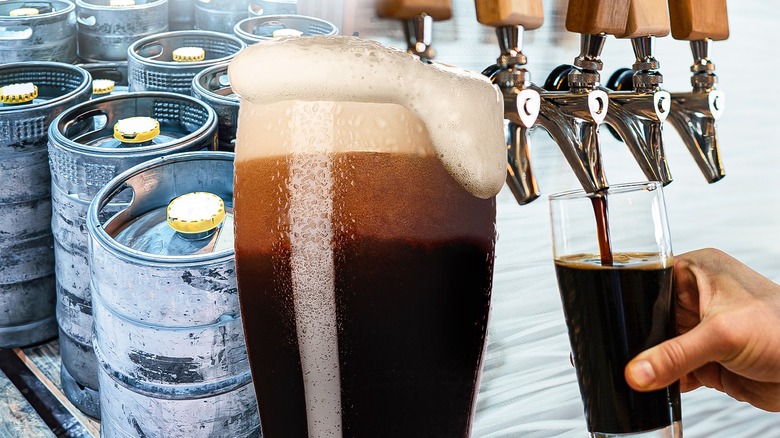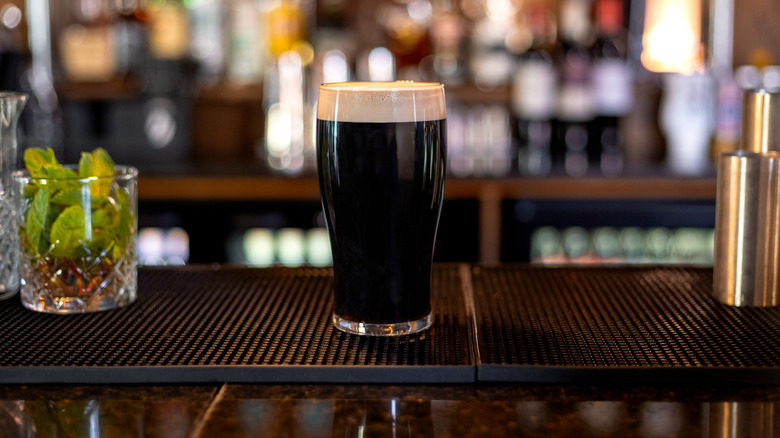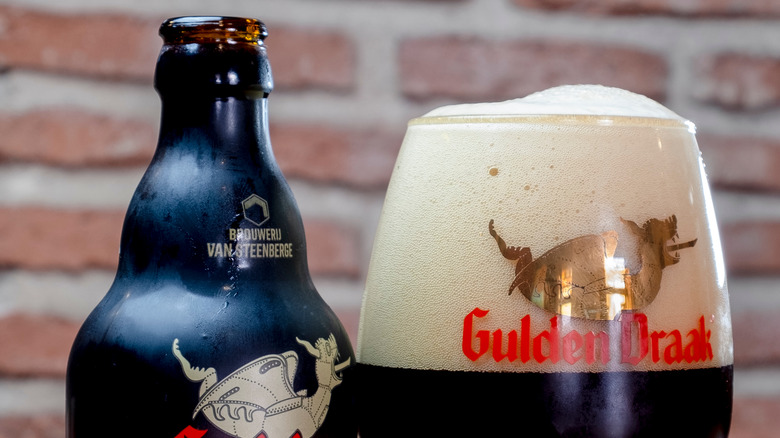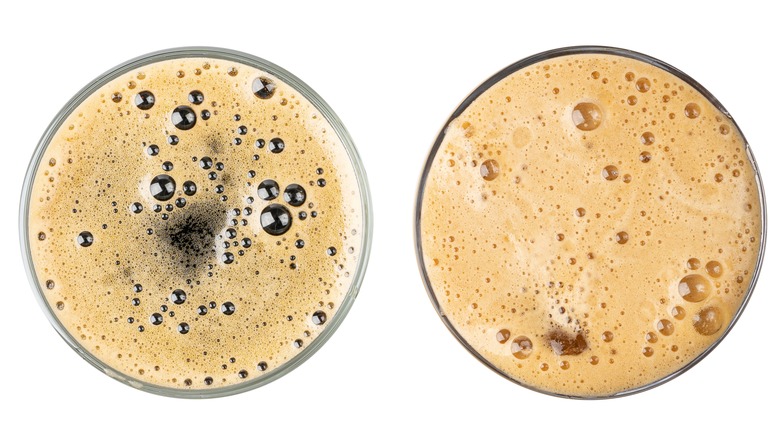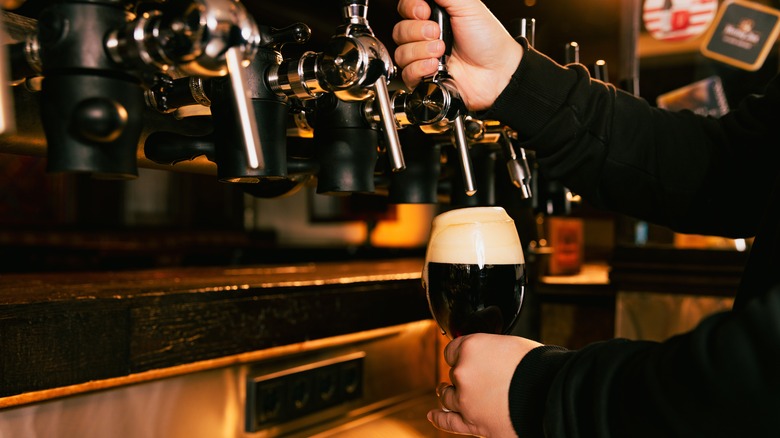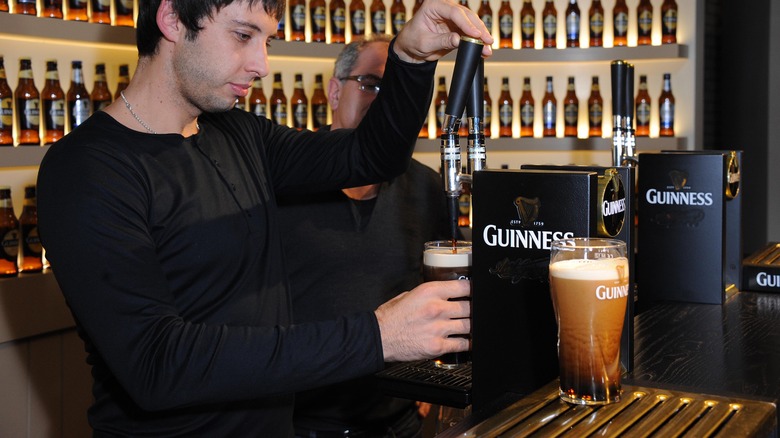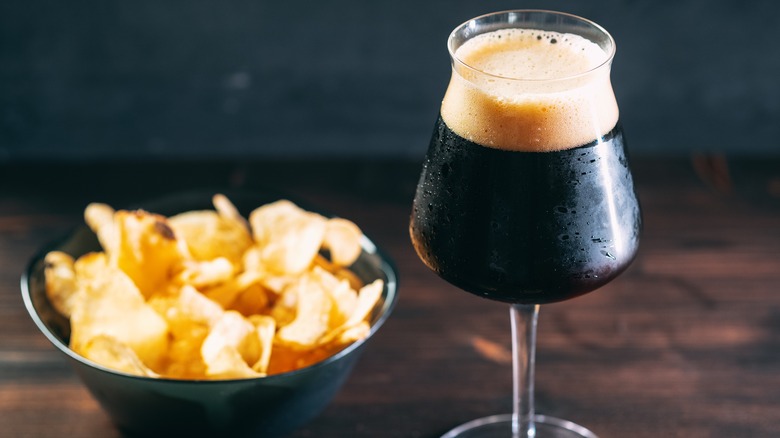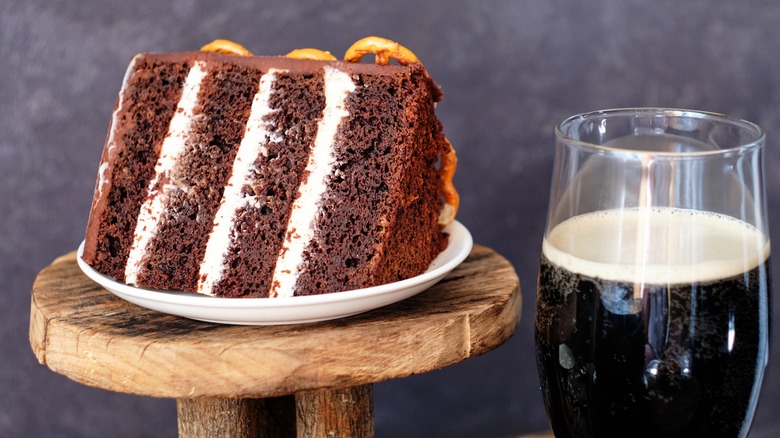What Is Stout Beer And How Should You Drink It?
We've all had our fair share of lagers, pilsners, and IPAs, but nothing quite matches the creaminess of a well-poured stout. You can find them in craft breweries, bars, and pubs across North America and the world. To the general beer drinker, stouts might seem like an acquired taste or niche preference. Their dark color and bold flavors can make it a bit intimidating to order a super dark beer if you're used to knocking back Coronas and Heinekens. But regardless of whether or not you consider yourself a beer aficionado, you may be inclined to expand your palate, and we're here to help.
Chowhound reached out to Jeff Manol, owner of the popular Muddy York Brewery in Ontario (and serious brewer) to find out everything we could about stout beers. We also checked in with bartender Charlotte Ives about her best tips for serving up a pint of the dark stuff. You may already love them, but if you haven't investigated yet, here's everything you need to know about stout beers and how to drink them. If you're stout-curious, now's the time to give one a go.
What is a stout, and how is it made?
Traditionally most popular in Great Britain and Ireland, you can find a stout just about anywhere these days. Guinness in particular has spread around the globe as one of the most iconic beers available, but it is just one of many stout beers.
"Generally speaking, a stout refers to a very dark colored beer with a pronounced roastiness," Jeff Manol explains. He says that stouts get their dark color from "highly roasted unmalted barley that is kilned to very high temperature (just like coffee) in drum roasters." Kilning is the process by which sprouted barley (or malt) is dried at higher or lower temperatures to get roast and color on the grain. This particular method allows the maltster "to get the rich, coffee-like, almost burnt roast character without the barley catching on fire when kilning."
Stouts fall under the category of "ales," and traditionally had higher alcohol content than other beers. But Manol says there's a misconception about these beers today. "Don't be fooled into thinking that just because the beer is dark, that it's 'heavy,' or more alcoholic," he says. A dry Irish stout like Muddy York's Dara Dry Stout is just 4.2% alcohol by volume, which is the same ABV to Coors Light. "Yet the flavour profile and texture is much richer and deeper due to the roasted barley and the earthiness of English grown hops." If you like these flavors, give stouts might be for you. Plus, you can find one at just about any ABV nowadays.
There are many varieties of stout
Irish stouts are likely what you're most familiar with. They tend to be blacker in color, with a coffee-like "pronounced roasted flavor," and maybe a hint of dark chocolate. They range from a little sweet to quite bitter and dry. "But don't stop at just a dry Irish Stout," Jeff Manol urges. There are countless styles for adventurous beer drinkers, with unique flavor profiles and a wide range in alcohol by volume. American stouts tend to be strong, bitter, and more hoppy. Foreign extra stouts have more pronounced roast flavors and are very dark, rich, and dry.
Oatmeal stouts are another common variety made with the addition of oats. They are full-bodied and roasty and sweet enough to jibe with the oat flavor. Tropical stouts are very dark but smooth with a sweeter, fruitier flavor profile. Sweet stouts are also very dark and full bodied, but a sip of sweet stout can evoke sweetened espresso or coffee with cream.
According to Manol, the Russian Imperial Stout, originally brewed for the Russian Imperial Court, is the biggest of the big beers. "These big and bold stouts routinely hit the 10-12% ABV range and can be aged beautifully just like any high quality wine," he says. If you're a beer connoisseur, you'll know that the world of microbrewing has a ton to offer, and new iterations of your favorite styles pop up all the time. Muddy York is about to launch their Inkwell Imperial Stout, and the aging process is complex. "We routinely age these big beers in French Cognac, Tawny Port or Sauternes Barrels for added complexity," Manol explains. Sounds almost like a fine Scotch.
What's the difference between a stout and a porter?
There are many different styles of light and dark beer, and stouts are just one kind of dark beer. There can be some confusion between stouts porters in particular, as stouts did evolve from porters historically. Porters are also dark beers that were very popular in London, England prior to the Industrial Revolution. "Before the invention of the coke fired kiln," Jeff Manol explains, brewers and maltsters had to dry barley over wood fires, which meant they were generally unable to produce a light colored malt. Because of this, the beers from that time were darker.
The stronger porters that were brewed then started to be called "stout porters" to differentiate them from lighter versions. Manol says the earliest reference to this name is around 1677. "As malting and drying techniques started to advance during the Industrial Revolution, better control over color was achieved," he says. "The style of stout [then] started to evolve and break away from its porter parentage."
Today, however, stouts are not merely a subcategory of porters. The principal distinguishing factor is the use of malted vs. unmalted barley. What does that mean for the drinker? "Stouts have more of a coffee or espresso flavor and aroma, and porters have more of a dark chocolate type of character," Manol explains. There is overlap in their characteristics, but Manol assures that they're distinct. "Once you taste them against each other and/or against a dark lager," he says, "the differences should be noticeable."
How should you pour and serve a stout?
Some people insist on pouring beer against the side of the glass to minimize foam and maximize the volume of liquid, but many experts will tell you that's not actually the best way to go. That foam, or "head," on the top of your beer is an important part of the drink, and releasing some of those gases can even aid with digestion. Nowhere is achieving this perfect head more important than when it comes to stouts. Much has been said and written about the perfect way to pour a pint of Guinness in particular.
Charlotte Ives says that head on a pint of stout should be about two fingers tall, have a nice velvety texture, and you won't want to serve it too cold. Jeff Manol agrees — cold isn't the way to go. You want your stout "not when it's cold, but after resting the can or bottled on the table for 10-15 minutes or so to let it warm slightly." If it's too cold, he tell us, you will not get the proper flavor or smoothness.
"Traditionally," Manol explains, "stouts would have been served directly from wooden casks stored in the cellar below the tavern and dispensed by a 'cask engine' or hand pump that draws the beer from below in the cellar." The casks wouldn't be very carbonated and would sit around 50-55 F. The combination of low carbonation and temperature, he says, is ideal. "[It] make[s] for a very smooth and easy drinking experience that does not cause bloating and is well suited to pairing with food."
So, what's all this about nitro?
Even Starbucks offers nitro cold brew now. But it's not just getting into your coffee, nitrogen pops up in the taps at the breweries too. So, what is nitro beer? Nitrogenated beers were popularized by Guinness, which started adding nitrogen to its stout casks back in 1959. Adding liquid nitrogen is meant to help maintain consistency and mimic the smooth head of their traditionally hand-pumped cask ale.
Famously, Guinness had a two-barrel system for pouring out pints impossible to replicate on a large scale. When bottled and shipped around the world, these low-carbonated beers can lose their signature look and texture. Liquid nitrogen is infused into the stout in a highly pressurized process, and when opened, it immediately tries to release, creating an impressive rush of tiny fine bubbles that helps achieve that perfect velvety head.
"Nitrogen does not absorb into liquids as readily as carbon dioxide, which is the standard gas in beer," Jeff Manol explains. "It also has smaller bubbles, which adds to a 'creamy' texture," rather than a harsher fizzy carbonation. This technique really started and became popular with stouts and porters, because that creamy texture is synonymous with their drinking experience. But it has since branched out, and brewers of all sorts of beers are experimenting with nitro brews.
What should you pair with a stout?
If you like a snack with your pint, you may be interested in the ideal food pairings with stout beers. "[A] bigger stout would definitely pair well with rich, bold meats," Jeff Manol says. You can enjoy a pint with some decadent BBQ. Or, if you like a cheese board, he recommends "funkier cheeses such as Stilton" and other blues to serve with your pint. Meanwhile, Charlotte Ives says she likes to pair a glass of stout with something sweet, like a piece of cake.
So, whether you're drinking your Guinness with a basket of fried food at the pub, over a charcuterie board at a dinner party, or with dessert, you can't really go wrong. In fact, you can even pair it with another beer — try a black and tan by filling half your glass with a lighter ale and topping it with stout, which is less dense and floats on the top.
You can try cooking with stout, too
If you want to go a step further and integrate stout right into your cooking, there are lots of recipes out there that benefit from a splash of dark beer. You can incorporate stout into meat marinades and beef stews. If you know coffee or dark chocolate flavors work well in a particular dish, you can probably bet stout will work similarly. Plus, the added carbonation from the beer can add to the texture and even work wonders in a batter for fish and chips.
While they taste great with meats like beef and pork, stouts are just as welcome in the dessert arena. Jeff Manol says the strong coffee notes in stout also make it a good choice for a boozy beer float with vanilla ice cream. If you loved a root beer float as a kid, you might love a stout float as a grown up. Manol says another one of his favorite desserts is a rich chocolate stout cake. They've been trendy for some time, but if you haven't come across one yet, you may want to try your hand at baking a Guinness cake with Irish cream.
